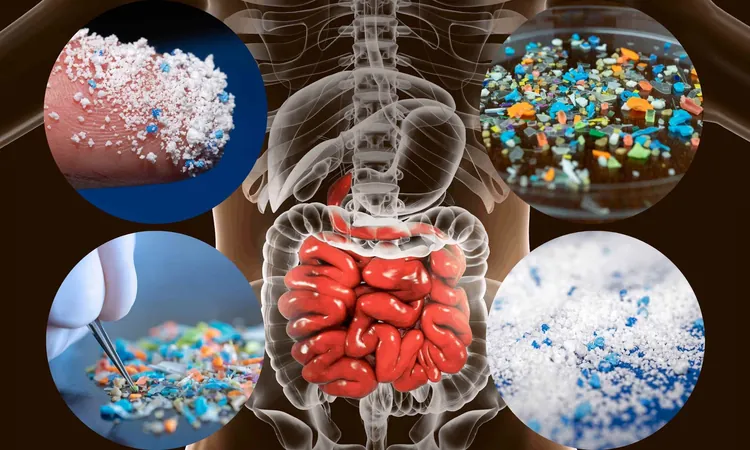
Alarming Discovery: Tiny Plastic Fragments Found Inside the Human Body!
2024-12-24
Author: Siti
Alarming Discovery: Tiny Plastic Fragments Found Inside the Human Body!
Recent revelations have sent shockwaves through the medical community: tiny plastic fragments, smaller than a grain of sand, have been discovered lurking within the human body. These unsettling findings raise serious concerns about long-term health implications and the pervasive nature of plastic pollution that has infiltrated our environment for decades.
The Insidious Infiltration of Microplastics
Micro- and nanoplastics (MNPs) have been identified in various human tissues, including the lungs, gut, reproductive organs, and skin. Surprisingly, researchers have now detected these particles in our blood as well, suggesting they do not simply pass through our bodies without consequence. Instead, they seem to settle in and may contribute to serious health issues.
A significant study led by Dr. Yating Luo from East China Normal University has highlighted the alarming reality of these contaminants. Recent investigations have linked MNPs to various health issues, including heart conditions like atherosclerosis and thrombosis, intestinal diseases such as inflammatory bowel disease, and even reproductive disorders, raising concerns about cervical cancer risks.
How Do These Particles Cross Protective Barriers?
One of the most shocking aspects of this research is the ability of MNPs to break through barriers previously thought to protect us, such as the blood-brain barrier. This discovery hints at potential neurological issues, as microplastics may impact nerve cell function—possibly playing a role in degenerative brain diseases.
Public Health Crisis: The Global Reach of Plastic Pollution
Plastic pollution is no longer confined to oceans and landfills. Studies reveal that tiny plastic particles can be found even in the most remote areas of the globe. From the air we breathe to the food we consume, these particles have infiltrated every corner of our lives. Dr. Tamara Galloway, a leading expert on microplastics, emphasized that this is a widespread problem affecting people globally, not just isolated communities.
The Urgency for Awareness and Action
In an era of excessive plastic use—from containers and packaging to clothing and personal care products—these materials continually shed tiny fibers and fragments into the environment. As plastic waste is mishandled, for instance through open burning, more harmful particles are released, impacting wildlife and nearby human populations.
The demand for stricter regulations surrounding plastic production, recycling, and disposal is more pressing than ever. Public health agencies must reconsider guidelines to account for these pervasive microplastic contaminants and their potential links to various diseases.
What Comes Next for Research and Action?
Scientists emphasize the need for extensive research to determine the extent of microplastic accumulation in human tissues and their effects on our cells and organs. New technology is being developed to track these particles and understand their behavior within the human body, potentially unveiling their chemical reactions and identifying vulnerable tissues.
Changing individual behaviors can also mitigate plastic exposure. By avoiding products that shed fibers, supporting eco-friendly brands, and advocating for improved waste management solutions, communities can contribute to the fight against this growing crisis.
The Power of Awareness and Advocacy
Discovering plastic fragments within our bodies is a wake-up call for many. Yet, this awareness can inspire change. By educating the public on the risks associated with microplastics, we can push for meaningful reforms and increased funding for better research. As scientists unravel more about these hidden dangers, staying informed will be crucial for shaping policies that might protect public health.
The fight against plastic pollution is far from over. Together, we can make a difference by demanding greater accountability from manufacturers and promoting healthier, sustainable choices for ourselves and the environment.



 Brasil (PT)
Brasil (PT)
 Canada (EN)
Canada (EN)
 Chile (ES)
Chile (ES)
 España (ES)
España (ES)
 France (FR)
France (FR)
 Hong Kong (EN)
Hong Kong (EN)
 Italia (IT)
Italia (IT)
 日本 (JA)
日本 (JA)
 Magyarország (HU)
Magyarország (HU)
 Norge (NO)
Norge (NO)
 Polska (PL)
Polska (PL)
 Schweiz (DE)
Schweiz (DE)
 Singapore (EN)
Singapore (EN)
 Sverige (SV)
Sverige (SV)
 Suomi (FI)
Suomi (FI)
 Türkiye (TR)
Türkiye (TR)